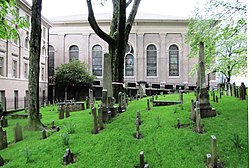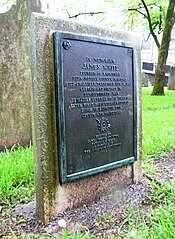231:
188:, in 1791, White ordered at least one lot to be set aside for a church and cemetery. The cemetery spot may have been used as early as the 1780s for burials, and the cemetery contained several graves by 1799, but the earliest marker is Blount's, dated 1800. While the First Presbyterian congregation was active in the 1790s, the first church was not built on the site until 1816. The graveyard was used for burials for nearly sixty years, its most active period being during the Epidemic of 1838, in which hundreds of Knoxvillians died from an unidentified illness.
58:
297:
197:
226:
The First
Presbyterian congregation was organized by the Reverend Samuel Carrick in the 1790s, and the first church was erected adjacent to the cemetery in 1816. Shortly after the church's completion, disputes arose over several matters, including the renting of pews, and a doctrinal dispute between
287:
The First
Presbyterian Church Graveyard resembles a traditional early Anglo-American cemetery, with graves crowded together and marked by relatively simple headstones. Most of the headstones are polished, upright stones, although a few (such as the Blounts') are flat stones. Most are adorned with
219:. McClung initially divided the town into 64 half-acre (0.2-ha) lots, and added additional lots in 1795, with the cemetery lot being included in the later additions. While the cemetery was not officially platted until 1795, historians speculate that burials likely occurred before that date. When
242:) swept through the town. Approximately one-tenth of the marked graves in the graveyard are dated "1838"— more than any other single year— and one tombstone mentions "the fever." The graveyard was open to new burials until 1857, but the last burial took place in 1879. During the
272:, feared walking past the graveyard at night, as many locals believed it to be haunted. Rather than leave work after his shift (which ended close to midnight), Ochs stayed until daylight, spending the extra time learning the typesetting and printing trades.
261:(1814–1869), an ardent Presbyterian, served as an elder of the First Presbyterian Church during his years in Knoxville. Two of his children, Harriet (1838–1846) and George (1841–1842), are buried in the graveyard.
319:(1749–1800), Governor of the Southwest Territory (1790–1796), U.S. senator from Tennessee (1796–1797), signer of the U.S. Constitution. His wife, Mary Grainger Blount (c. 1761–1802), is buried next to him.
592:
612:
288:
simple inscriptions noting the deceased's name, date of death, and number of years lived. A low iron fence surrounds the graveyard's perimeter, and crude stone walkways allow access.
161:, United States. Established in the 1790s, the graveyard contains the graves of some of Knoxville's most prominent early residents, including territorial governor and
510:
Dean
Novelli, "On a Corner of Gay Street: A History of the Lamar House—Bijou Theater, Knoxville, Tennessee, 1817–1985." East Tennessee Historical Society
85:
607:
587:
602:
227:"Old Calvinists" and "Hopkinsians". A portion of the congregation split from First Presbyterian, and founded Second Presbyterian Church circa 1818.
339:
Thomas Humes (1767–1816), church elder and early
Knoxville businessman, builder of the Lamar House Hotel building (now houses the
597:
20:
566:
223:
missionary
Frederick de Schweinitz passed through Knoxville in 1799, he reported that the cemetery already had numerous burials.
215:, James White asked his son-in-law, surveyor Charles McClung, to lay out a new town, named "Knoxville" after Secretary of War
366:
360:
174:
44:
379:
117:
385:
350:
251:
340:
258:
333:
326:
247:
162:
264:
In the 1870s, the graveyard had an indirect effect on the career of future newspaper publisher,
571:
356:
276:
254:
soldiers (who occupied the town 1863–1865) used the church as a hospital and barracks.
230:
201:
170:
535:
The Future of
Knoxville's Past: Historic and Architectural Resources in Knoxville, Tennessee
332:
John
Craighead (1783–1826), church elder and early Knoxville alderman, builder of the
158:
73:
8:
542:
For Christ in the Heart of
Knoxville, A History of Knoxville's First Presbyterian Church.
212:
57:
534:
530:. (Knoxville: The Knoxville Heritage Committee of the Junior League of Knoxville, 1976).
243:
133:
390:
346:
325:(1760–1809), the church's founder; first president of Blount College (now the
349:(1773–1840), U.S. senator (1825–1840), presidential candidate in 1836 (
560:
459:
268:. Ochs, then a young teenager working after hours as a "printer's devil" for the
250:
soldiers (who occupied the town 1861–1863) kept horses in the cemetery, and
208:
185:
322:
316:
301:
166:
581:
100:
87:
313:
for killing a Union veteran at the Knox County
Courthouse in September 1865.
296:
544:
Compiled by Ashley Mack for the church's bicentennial celebration in 1992.
265:
196:
216:
238:
In 1838, hundreds
Knoxvillians died when an unknown illness (possibly
426:(Knoxville, Tenn.: University of Tennessee Press, 1999), pp. xvi-xix.
154:
62:
First Presbyterian Church Cemetery, with the church in the background
501:(Knoxville, Tenn.: East Tennessee Historical Society, 1976), p. 635.
593:
Cemeteries on the National Register of Historic Places in Tennessee
574:; contains information about the politicians buried in the cemetery
310:
563:— contains the inscriptions of all the cemetery's headstones
486:
Printer's Devil to Publisher: Adolph S. Ochs of the New York Times
275:
The present First Presbyterian Church, constructed in 1903, is a
239:
220:
538:(Knoxville Historic Zoning Commission, October 2006), page 24.
497:
East Tennessee Historical Society, Lucile Deaderick (editor),
424:
The Marble City: A Photographic Tour of Knoxville's Graveyards
613:
National Register of Historic Places in Knoxville, Tennessee
567:
The Centennial Anniversary of the First Presbyterian Church
181:
561:
First Presbyterian Church Cemetery — official site
499:
Heart of the Valley: A History of Knoxville, Tennessee
460:
First Presbyterian Church Knoxville — Graveyard
439:(Tulsa: Continental Heritage Press, 1982), pp. 17-22.
309:
Abner Baker (1843–1865), a Confederate veteran
19:
For other First Presbyterian Church cemeteries, see
369:(1778–1837), U.S. senator (1815–1823).
579:
363:placed a bronze plaque on his headstone in 1932.
211:was chosen as the capital for the newly created
353:). Buried adjacent to his father, James White.
608:1792 establishments in the Southwest Territory
359:(1747–1821), Knoxville's founder. The
279:, with a Tiffany-style stained glass window.
16:Historic cemetery in Tennessee, United States
588:Presbyterian cemeteries in the United States
550:. (East Tennessee Historical Society, 1965).
418:
416:
414:
412:
410:
408:
406:
603:Tourist attractions in Knoxville, Tennessee
282:
173:. In 1996, the graveyard was added to the
56:
403:
304:(left) and his wife, Mary Grainger Blount
45:U.S. National Register of Historic Places
455:
453:
451:
449:
447:
445:
295:
229:
195:
572:The Political Graveyards of Knox County
580:
437:Knoxville: Crossroads of the New South
548:Knoxville's First Graveyard 1800-1879
442:
291:
488:(New York Messner, 1963), pp. 24-25.
361:Daughters of the American Revolution
175:National Register of Historic Places
151:First Presbyterian Church Graveyard
13:
521:
234:First Presbyterian Church, c. 1906
37:First Presbyterian Church Cemetery
14:
624:
598:Geography of Knoxville, Tennessee
554:
475:(Scruffy Books, 1995), pp. 46-7.
380:List of cemeteries in Tennessee
200:Marker of Knoxville's founder,
184:Knoxville with his son-in-law,
504:
491:
478:
465:
462:. Retrieved: 11 January 2013.
429:
128:
1:
396:
122:Knoxville and Knox County MPS
26:United States historic place
7:
514:, Vol. 56 (1984), pp. 3-45.
386:Knoxville National Cemetery
373:
10:
629:
528:Knoxville: Fifty Landmarks
473:Knoxville's Secret History
191:
18:
163:Constitutional Convention
139:
127:NRHP reference
126:
116:
79:
71:Adjacent to 620 State St.
67:
55:
51:
42:
35:
31:
21:First Presbyterian Church
435:William MacArthur, Jr.,
283:Layout and marker styles
259:George Washington Harris
334:Craighead-Jackson House
327:University of Tennessee
305:
235:
204:
169:and Knoxville founder
299:
277:Neoclassical building
233:
199:
159:Knoxville, Tennessee
74:Knoxville, Tennessee
329:), 1794–1809.
270:Knoxville Chronicle
213:Southwest Territory
101:35.9643°N 83.9161°W
97: /
306:
292:Notable interments
236:
205:
391:Old Gray Cemetery
347:Hugh Lawson White
147:
146:
106:35.9643; -83.9161
620:
515:
508:
502:
495:
489:
482:
476:
469:
463:
457:
440:
433:
427:
420:
143:December 4, 1996
130:
112:
111:
109:
108:
107:
102:
98:
95:
94:
93:
90:
60:
29:
28:
628:
627:
623:
622:
621:
619:
618:
617:
578:
577:
557:
524:
522:Further reading
519:
518:
509:
505:
496:
492:
483:
479:
470:
466:
458:
443:
434:
430:
421:
404:
399:
376:
294:
285:
207:In 1790, after
194:
186:Charles McClung
105:
103:
99:
96:
91:
88:
86:
84:
83:
72:
63:
47:
38:
27:
24:
17:
12:
11:
5:
626:
616:
615:
610:
605:
600:
595:
590:
576:
575:
569:
564:
556:
555:External links
553:
552:
551:
545:
539:
531:
523:
520:
517:
516:
503:
490:
477:
464:
441:
428:
401:
400:
398:
395:
394:
393:
388:
383:
375:
372:
371:
370:
364:
354:
344:
337:
330:
323:Samuel Carrick
320:
317:William Blount
314:
302:William Blount
293:
290:
284:
281:
193:
190:
167:William Blount
153:is the oldest
145:
144:
141:
137:
136:
131:
124:
123:
120:
114:
113:
81:
77:
76:
69:
65:
64:
61:
53:
52:
49:
48:
43:
40:
39:
36:
33:
32:
25:
15:
9:
6:
4:
3:
2:
625:
614:
611:
609:
606:
604:
601:
599:
596:
594:
591:
589:
586:
585:
583:
573:
570:
568:
565:
562:
559:
558:
549:
546:
543:
540:
537:
536:
532:
529:
526:
525:
513:
507:
500:
494:
487:
484:Doris Faber,
481:
474:
468:
461:
456:
454:
452:
450:
448:
446:
438:
432:
425:
419:
417:
415:
413:
411:
409:
407:
402:
392:
389:
387:
384:
381:
378:
377:
368:
367:John Williams
365:
362:
358:
355:
352:
348:
345:
342:
341:Bijou Theatre
338:
335:
331:
328:
324:
321:
318:
315:
312:
308:
307:
303:
298:
289:
280:
278:
273:
271:
267:
262:
260:
255:
253:
249:
245:
241:
232:
228:
224:
222:
218:
214:
210:
203:
198:
189:
187:
183:
178:
176:
172:
168:
164:
160:
156:
152:
142:
140:Added to NRHP
138:
135:
132:
125:
121:
119:
115:
110:
82:
78:
75:
70:
66:
59:
54:
50:
46:
41:
34:
30:
22:
547:
541:
533:
527:
512:Publications
511:
506:
498:
493:
485:
480:
472:
471:Jack Neely,
467:
436:
431:
423:
422:Jack Neely,
286:
274:
269:
263:
256:
237:
225:
206:
179:
150:
148:
357:James White
266:Adolph Ochs
248:Confederate
202:James White
171:James White
104: /
80:Coordinates
582:Categories
397:References
351:Whig Party
300:Graves of
217:Henry Knox
92:83°54′58″W
89:35°57′51″N
257:Humorist
244:Civil War
165:delegate
155:graveyard
374:See also
221:Moravian
209:his fort
182:platting
134:96001400
68:Location
311:lynched
240:malaria
192:History
180:While
252:Union
149:The
157:in
129:No.
118:MPS
584::
444:^
405:^
343:).
246:,
177:.
382:.
336:.
23:.
Text is available under the Creative Commons Attribution-ShareAlike License. Additional terms may apply.



